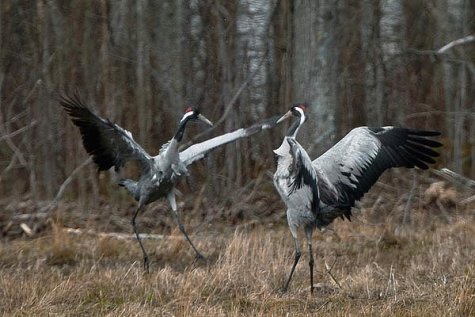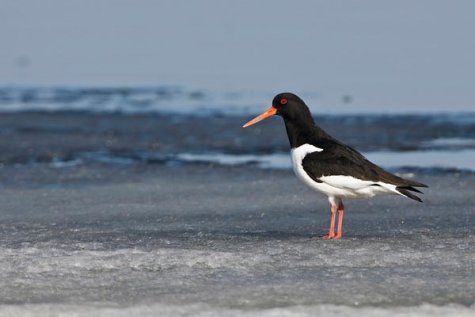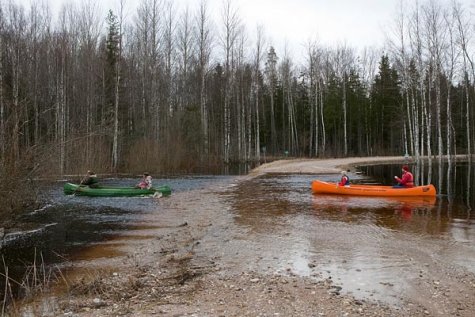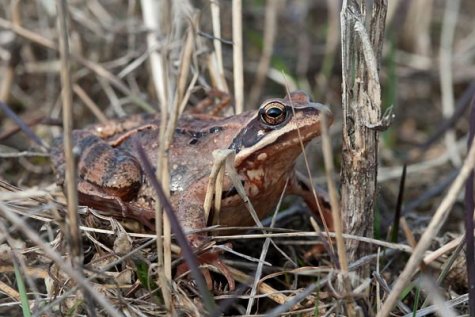Second week of April: refrigerator deiced
The crucial moment when fishermen are no longer allowed to go out on the ice arrived last Wednesday. At half past six on the evening before the ban we went out to have a look on what was going on in the ice fields. The ice-free shore meadows were full of hundreds of fieldfares and redwings, who all tried to outtalk each other. On the shore bank crows were dissecting the thawed seaweed heaps. A couple of hundred of meters away, at a crack in the ice, were ducks, goosanders, gulls ... some great crested grebes in the open water. A kilometre out in the fog, however, were five fishermen, it seemed that they meant to stay there so that they would not to break the law by going out on the ice again in the morning. I didn’t go to look if they managed to get back – those crested grebes in the open ice crack dived underwater for several minutes … Well - maybe these people had had too little outdoors learning when they were young and so did not understand the signs of nature. Mikk Sarv says that we have focused on teaching children and forgotten about bringing them up. Poorly brought up children don’t understand, when they have grown up, that you may even be left on the ice when the cracks widen. Outdoors learning supports learning and growing together, so we should celebrate Outdoor Education Day on April 14, when we leave the indoors classrooms for a half-year of outdoors learning.
Bird people enjoy life most at the moment. After the first wave of migrants, the rear guard has arrived. The sea and forests are full of all kinds of shorebirds – snipes already croak on their evening wooing patrol flights, the "bleaters" or common snipes bleat, the green sandpiper flies with quick shrill cries. The cranes hold dancing balls in the morning mists, white storks trawl in frog ponds, and stand in pairs on the nests. Evenings and mornings are filled with never-ending chattering from chaffinches, blackbirds, redwings, fieldfares. The robin drips its pearls in the bushes, the dunnock sings in a spruce top. To the enjoyment of the city people the black redstarts sing between the panelled houses in self-oblivious rapture. The hurry-scurry of geese hither and dither goes on day and night. And the starlings ... they even press inside – excactly, clinging to the wooden window frame, they try to squeeze through the glass as if saying, for god’s sake, come on, build some more nest boxes.
Many have already held the first blue liverwort (Hepatica) flowers of this spring in their hands, or the first chubby yellow little tufts of the colt’s–foot. In western Estonia hosts of crocuses are said to glow in the flowerbeds, and the first scillas too. In our place here at Peipsi there are only the first white shafts of crocuses beside the red clump of the rhubarb. And the marsh marigold pushes its crinkly new leaves through the water towards the sun. Kaja Kübar says that in the Nigula fenland all the hare’s-tail cottongrass is in flower, alders and hazels scatter their pollens, and the bird-cherry has green mouse-ears. And in the garden the ground elder or “crow’s toe” is already quite tall. The Tallinn parks have their yellow flower period – the lesser celandine is in flower.
This year’s first floods are here, but only in places that are somehow connected to large inland waters. Peipsi for instance doesn’t even think of accepting the water from the rivers that flow out into it. Avijõgi at Avinurme is far above its banks, such as it has not been for years. Even Mustijõgi demonstrates its power this year, straight in the middle of Mustvee town. In Soomaa the water level has fallen but large portions of the road have also disappeared with the waters. Emajõgi spreads out on the water meadows but is slowly receding. The Nõiakaev, Witches’ Well, stopped its bubbling, but Peipsi broods on in silence under its white ice cover. But in Saaremaa the fishermen can already enjoy the first roach catches. Near Paatsalu Enn Vilbaste saw a toad padding along towards its wedding-pond, and in Soomaa common frogs are busy jumping across roads, all together. Drivers, please reduce your speed!
In folk-tales the snake king is a symbol of great power and wisdom. There is a game that tests children’s knowledge. The first snake king is elected by drawing lots and he climbs up on a stone or tree stub. The new snake king’s head is garnished with a crown. Then the rest of the players take turns to ask the snake king questions. If there is a question that the throne-owner cannot answer he must descend from his high place to the ground and submit the crown to the questioner – the clever questioner becomes the new snake king. Well, this system might be used in state government too.
In Soomaa common frogs are busy jumping across roads together.













